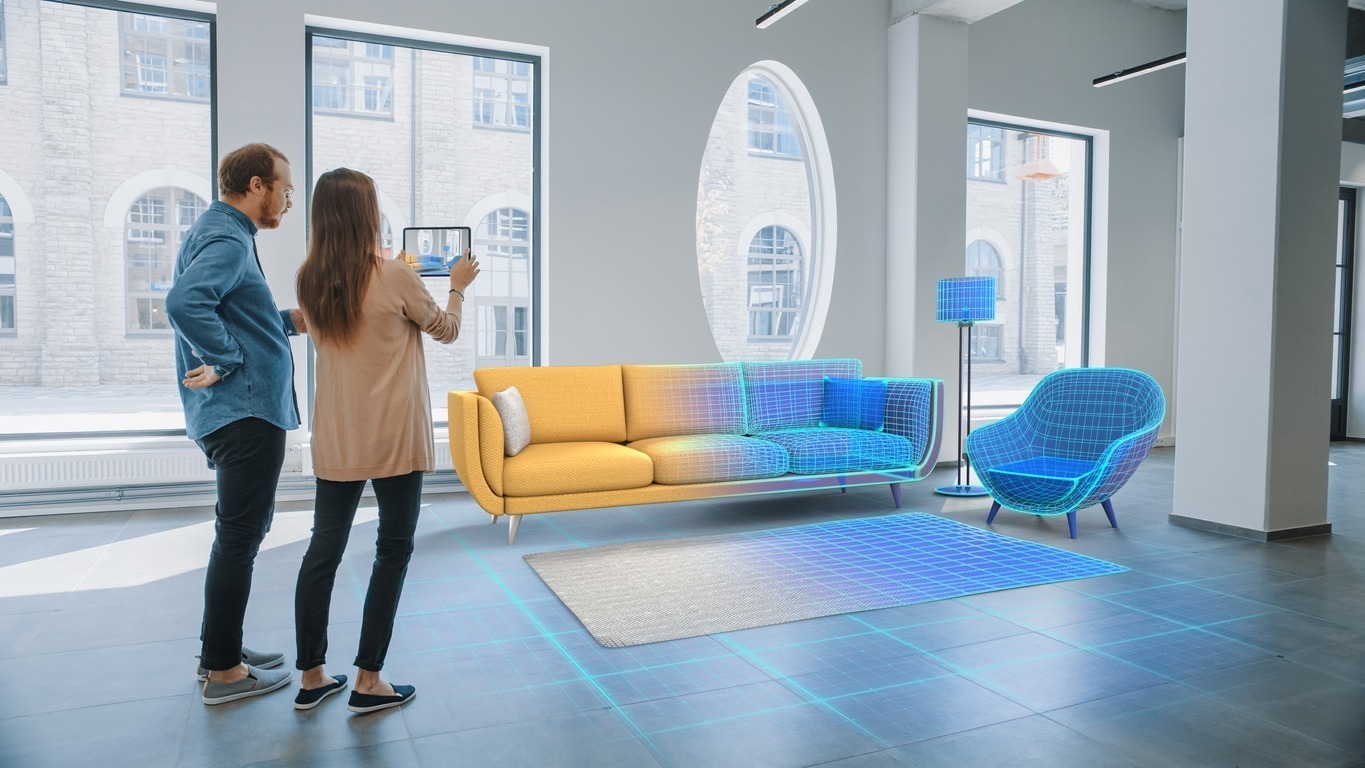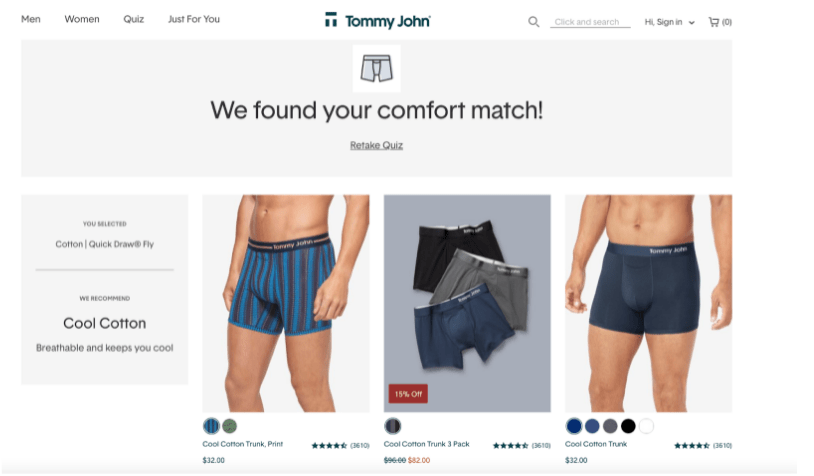Voice commerce, artificial intelligence (AI), and augmented reality (AR) are three of the driving forces behind increased convenience in ecommerce customer experiences for 2021. Keep reading to see how retailers are using them, and how you can integrate these cutting-edge technologies for your store.
Let’s start with the obvious. To say the least, ecommerce is booming. Thanks to pandemic restrictions, and a huge investment in innovation, online buying has officially hit its heyday.
Retailers are currently sitting on a gold mine of potential. All they need to do is reach out – and create experiences customers love. Lucky for merchants, there’s never been a better time to innovate with powerful technologies that deliver exactly that.
However, at the core of those expectations lies one thing: convenience.
Convenience in ecommerce comes in endless forms: expedited data entry at checkout, instant shipping rates, delivery date information, diverse payment options, guest checkouts, and more. But one aspect of convenience in ecommerce that’s only recently gained real traction is experiential ecommerce, in the form of voice commerce, AR, and AI. What was once a nice-to-have facet of online buying has now become par for the course. It’s an essential aspect of the customer experience for retailers hoping to break into the market as leaders.
Let’s take a look at the technologies that are driving convenient and customer-centric buying for retailers across industries.
Getting Behind Voice Commerce
Voice commerce is a method of shopping that allows customers to simply ask for what they want, using technology like smart home speakers or mobile devices. The innovation has been celebrated as an innate form of shopping compared to browsing with a keyboard. In 2020, voice commerce accounted for $2 billion in sales. However, that number is expected to skyrocket past $40 billion by 2022.
“Voice is a much more natural experience for humans than typing, which is a big part of what I think is driving consumer adoption of voice commerce,” says Darin Archer, CSO at Elastic Path.
Unsurprisingly, Amazon has been the key trailblazer for the voice commerce industry, powering voice interactions with its Alexa AI feature. With more than half of the smart speaker market all to itself, the brand has done more than any other to move the state of voice commerce forward. With Alexa, customers can ask for product recommendations, reorder essentials, add products to shopping or wish lists, and ask to hear different options for a product. Thanks to Amazon’s end-to-end purchase cycle, it also lets customers ask Alexa to track packages.
Customers enjoy voice shopping because of its convenience, but they also appreciate its novelty. Without ever having to type a letter, they can browse and buy the items they want, based on shopper data and reviews they trust. Customers flock to retailers offering cutting edge shopping experiences. Falling in line with the strong push toward hyper-personalization in ecommerce, voice shopping brings a whole new level of personal convenience to online buying. Retailers can benefit from the brand loyalty that comes with the ability to simply tell a device to reorder a product they’ve purchased before – even down to the quantity, brand, and style of each item.
“As the tech becomes good enough that my Alexa can almost always give me a coherent – if not eloquent and helpful – response, no matter what I throw at it, it’s no wonder the tech is starting to move away from niche novelty to a real commerce touchpoint,” Archer says.
While Amazon devices limit searches to products sold on Amazon, Google also offers voice commerce options, opening up a world of possibilities for retailers of all kinds to get their products featured in the search results for voice inquiries.
While the popularity of voice commerce is increasing, only 5.5 million adults say they make purchases using their smart speakers, despite more than 90 million households having a device. This underscores the serious opportunity retailers have for exponential growth in the voice commerce space.
Looking ahead, 54% of voice search users say they believe their digital assistants will help them make retail purchases, and 38% say they’d like these devices to actually understand purchase preferences. It’s clear that as smart technology progresses, we can expect voice commerce to follow suit.
How Big Brands Are Innovating with Voice
While voice commerce is relatively new to the ecommerce sector, many of the largest players in the game are eagerly jumping on board.
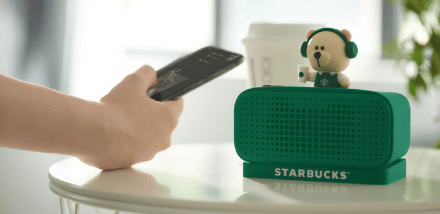
In a dazzling display of convenience and innovation, Starbucks partnered with Alibaba to create a world-first smart speaker, dedicated to the chain’s popular coffee drinks.
Although only available in China, the speaker allows customers to place orders on the speaker for delivery to their location. Of course, payment and address details can be saved ahead of time, demonstrating one of the most seamless displays of voice commerce on the market.
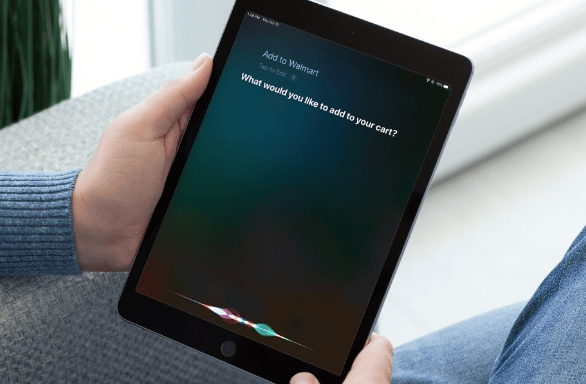
Walmart introduced Voice Order in 2019, later announcing an integration with Apple’s Siri AI technology, making ordering even more seamless for iOS users. Focused primarily on grocery ordering, customers can order items on the way home and pick them up curbside or opt for same-day delivery for a totally touchless experience.
Voice Commerce for Smaller Retailers
Of course, not every brand has the resources to build a dedicated AI for customers to shop with voice commands. But that doesn’t mean they can’t get on board with the technology.
Those with the proper resources may find value in adding a voice search feature on their shopping apps. This can make viable one of the most revenue-driving aspects of voice commerce: reordering. Restocking on everyday items you know and trust is a more realistic use case for voice ordering rather than placing an order cold, without research or a bit more product information.
Sellers in the Amazon Marketplace can start by setting up an Alexa Skill. However, this step only allows for purchasing through the Amazon platform.
For the majority of independent sellers, the best way to get ahead of the voice commerce curve is to make sure your products can be featured in voice search results.
Perhaps the most lucrative place for your products or brand information to show up is in featured snippets on Google results pages. These “position zero” excerpts are pulled from search results as the most relevant possible to a voice search inquiry. In fact, more than 40% of the results that users are served with voice searches come from featured snippets.
Keep in mind that voice search queries may be quite different from typical queries. For example, a customer is more likely to say “Google, what’s the difference between a kayak and a canoe,” whereas a customer might more likely type “kayak vs canoe.” Finding and creating content that answers natural-language questions in this way is a powerful way to increase your rank in voice search results. Be sure to address these common questions through SEO-driven initiatives, such as through your blog, FAQ, or directly on product pages, to increase the likelihood of customers discovering your brand using voice search.
Smart Shopping Through Artificial Intelligence
Voice commerce shares a close relationship with its cousin, AI, or artificial intelligence.
AI is a buzzword that’s thrown around loosely across virtually every sector of technology. While it might seem like a highly technical concept, it’s really pretty simple: it’s technology that uses data to simulate human decision-making or behavior. Sometimes called machine learning, AI has impacted ecommerce in an especially significant way.
AI is a very broad concept to nail down, so let’s go a little more narrow. For ecommerce specifically, AI offers value by personalizing customer experiences. This usually comes into play during the product discovery process, helping customers find and explore products that interest them. In the early days of ecommerce, customers had to manually search for products they liked with specific search queries or through long pages of scrolling. AI makes it easy for retailers to show customers products they’re likely to be interested in, and help them get a better idea of what they’ll be like in person.
One of earliest demonstrations of the value of AI was a contest Netflix held in 2009. The contest promised a bounty of $1 million to the person (or company) that could increase the accuracy of its recommendation engine by 10%. The winning company increased accuracy by 10.06% and took the entirety of the three-year contest to build its algorithm. Clearly, the importance of accurate recommendations was not lost on the media company – Netflix had its priorities straight far ahead of competitors.
Let’s explore some of the most common ways retailers use AI today:
Chatbots
Conversational chat interfaces have become extremely popular among ecommerce sellers. Powered by AI, they help customers with problems. Most often, chatbots are used to answer frequently asked questions, complete simple tasks, or help customers find what they’re looking for. These handy communication features save retailers time by handling simple customer requests, giving them the ability to solve complicated problems or focus on improving experiences instead. Customers also appreciate chatbots because they save them time otherwise spent waiting for assistance from another person.
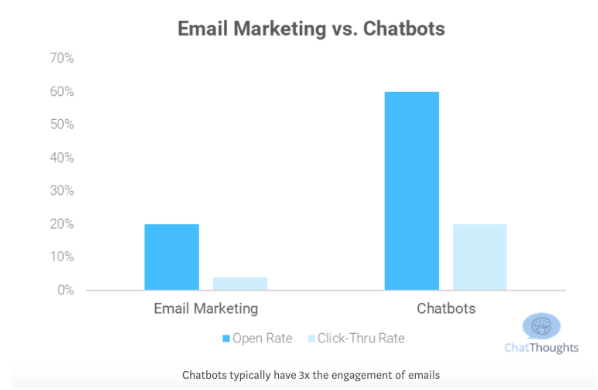
Thanks to the unprecedented convenience they provide, the popularity of chatbots is only expected to increase in coming years. Experts predict that by 2025, 95% of customer interactions will be powered by AI. Customers have high expectations for chatbots and rely on them heavily.
Seventy-one percent of people use chatbots to help them solve problems quickly, 56% prefer to use a message service over calling, and 53% of customers are more likely to shop with a business they can message.

One of the most true-to-form customer service innovations, chatbots connect businesses and customers seamlessly. By interacting with customers during their website engagement, retailers can help mitigate cart abandonment caused by frustration, and use these interactions to learn from customers about how to improve their offering.
Chatbots are ubiquitous these days, and vary in functionality from the most basic, which can answer common questions or refer to customer support, to advanced ones that can conduct transactions and complete complicated tasks. One way retailers can leverage chatbots without significant development costs is with Apple Business Chat. The feature is aimed at customers and promotes the access it gives them to companies of all sorts. Through Apple Business Chat, customers can reach a chatbot or live agent to get additional company information, make transactions and more. Google Business Chat offers a similar feature. To gain access to features like this, all you have to do is register your business with Apple and Google, respectively.
Uniqlo’s Mind-Reading Chatbot

Japanese clothing retailer Uniqlo has its eye on innovating with AI in creative ways. With its machine-learning powered UMood kiosk in select stores, customers could get uniquely personalized recommendations for a limited time. Using neurotransmitters, the kiosk shows customers a variety of products and measures their reactions to each of them. Based on those reactions, UMood suggests styles and products the customer is likely to prefer. Without even pushing a button, customers are analyzed and served with hyper-personalized recommendations. While personal style is still nearly impossible to nail down, it’s tough to deny the subconscious reaction we have to products right in front of us.
Visual Search
Much like voice commands, visual search is a more natural, human way to find items that appeal to us. We’re visual creatures and can identify images within 13 milliseconds. As a whole, we gain much richer information through visual means. Because of this, it comes as no surprise that visual search is gaining traction in a market obsessed with customer-centricity.
Visual search lets customers use images to search for related items. It’s widely appealing to customers because it’s convenient, fast, and downright cool.
See a pair of shoes you’ve gotta have on the train? Traditional search might have you typing in keywords you think might be relevant and hunting for the exact match. Visual search, however, lets you snap a picture of the shoes and find the exact same ones for yourself. While the step between seeing and buying is traditionally a painpont – trying to get customers to remember the details of the product, identify the brand, and more – visual search makes the process instant and accurate. In short, visual search shortens a friction-heavy portion of the buying process.
Let’s see how one company is using visual search in its digital strategy:
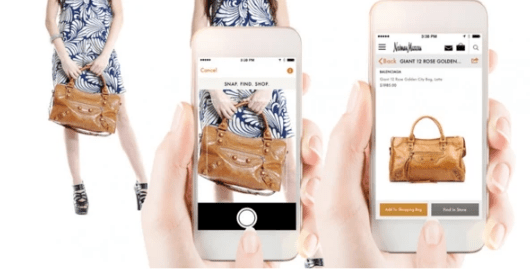
Luxury retailer Neiman Marcus uses AI to power its visual search feature on its Snap. Find. Shop. app. The feature lets users take pictures of items they see any time, anywhere, and find similar items within the Neiman Marcus catalog. Although it does introduce another step (downloading the app), for brands like Neiman Marcus with relatively high average price points, its audience is more inclined to be interested in finding exact matches for high-dollar items that catch their eye.
Of course, not every brand has the ability to launch a mobile app, nor create visual search features. A good workaround is to ensure your products appear in visual searches conducted on search engines (think: images.google.com). If a customer uploads a picture of an item similar to the ones you sell, your products could populate in the results page. Be sure to tag essential information like brand, color, price, and any attributes that make it unique. This way, you can take advantage of visual searches, without a massive effort upfront.
Text Orders
Although text messages carry something of an early-2000s vibe, they’re still the most widely used functionality on smartphones today, with more than 6 billion texts sent daily. Text messaging offers a uniquely convenient functionality for retailers to communicate with established customers. They can be used for re-engagement, promotional offerings, order updates, or most lucratively – reordering. Using AI to incorporate user information, preferences, and payment options, it creates a seamless system for reordering, driving customer loyalty.
If a customer has opted into receiving texts, you can be certain they’re invested enough in your brand to welcome your communication. Such a direct and difficult-to-ignore form of communication offers unprecedented closeness with customers, so be sure to leverage it wisely.
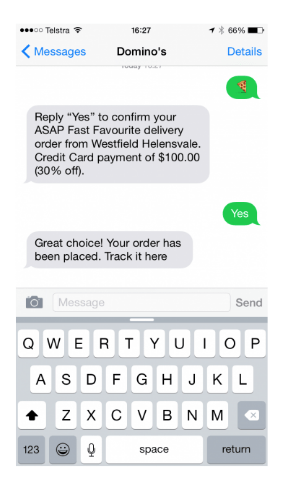
Let’s talk reordering.
As a consumer, you might twist your head at the concept of placing an order through a simple text message. On the surface, it might seem overly simplistic or strange. But what if it were for items you already know you want and need.
Check out these examples.
Domino’s has dominated the digital space since the brand had a makeover back in 2010. With no signs of slowing, the company continues to innovate with features like text message ordering. Once a customer identifies a favorite delivery option within their account, they can easily place an order via text message, simply by sending the pizza emoji. Triggered a simple confirmation, Domino’s places an order using saved delivery and payment information for a truly effortless ordering process.

Another example to explore is that of household staples. There are plenty of items we need to have on hand at all time – items like razors. In an effort to compete with direct-to-consumer brand Dollar Shave Club, Gillette went through a major rebrand, upping its digital offering significantly. With its Gillette On Demand program, customers can reorder blades that match their razor any time. All they have to do is text “Blades” to 252337 (BLADES). Like magic, a few days later, customers will find blades waiting at their dootstep. With a product that requires such reliable and frequent reordering, it’s a smart move that ensures brand loyalty through convenience.
Robots for Fulfillment
AI doesn’t just help on the front end. Increasingly, retailers are relying on AI to increase efficiency behind the scenes as well. AI-powered robots are being used for fulfillment across the world, and they’re saving brands millions on labor that would otherwise have required human interaction.
Solutions like the AI-powered SORT systems are able to take pressure off human workforces by performing repetitive tasks like picking and sorting. Underscored by the monumental growth ecommerce saw in 2020, these robots are more vital than ever to keep up with increasing order loads in high-volume ecommerce operations.
Home improvement warehouse Lowes uses robots in a more consumer-facing way. The company began using robots in stores to help customers in 2020. The cleverly-named LoweBot asks customers if they need assistance, then directs them around the store to the items they need. The robots also offer advice on specialty projects and passively monitor shelf inventory.
How Can Smaller Brands Leverage AI?
Remember, at its core, AI is simply using data to make informed predictions about behavior and preferences. While the average ecommerce seller certainly doesn’t have the ability to offer a mood-ring like preference selector, they can use the data they have to make decisions and help improve customer experiences.
The first step is to ensure you’re collecting and storing data in a way that allows you to learn from it – and leverage it. Good there? Now, you should turn your attention to your customers: what gaps exist in my customer experience could be bridged using data? Find the weak spots in your process and work from there.
Perhaps customers often leave off essential accessories when purchasing something like homebrew kits. Using AI, you can offer them the exact accessories they’re likely to need based on their browsing data and cart contents. On the other hand, if customers browsing your hats are struggling with head measurements, a chatbot on product pages can help. Got products you know people want, but they still have trouble finding? Consider enhancing your product and image tagging measures so they can appear in visual searches. Many of these capabilities are available on ecommerce platforms directly out of the box, and others can be added with simple integrations. If you’re ready to dive deep, consider developing an app that features these or other key AI-powered features to bring next-level service to your customers.
The New Try Before You Buy: AR
Pivoting again within the family, AI’s tech-savvy cousin, augmented reality (AR) must be included in the dinner conversation.
AR relies heavily on AI to create immersive experiences that turn online shopping into a much more tangible, personal experience. Playing off one of the inherent weaknesses of online buying – the inability to feel or experience a product before buying it – AR turns the issue on its head by creating experiences customers love.
Augmented reality lets customers see and experience products in a relevant environment before making a purchase. There are a bevy of use cases for this cutting edge technology, and ecommerce retailers are taking note. AR not only helps drive conversions by inviting customers to experience product benefits before they buy, it also decreases returns because of the unparalleled understanding they gain from experiencing the product before they buy. Customers love having the ability to see the product contextually, and retailers love the increase in conversions and engagement the features deliver.
Let’s see how retailers are leveraging AR today.
Social Media Filters
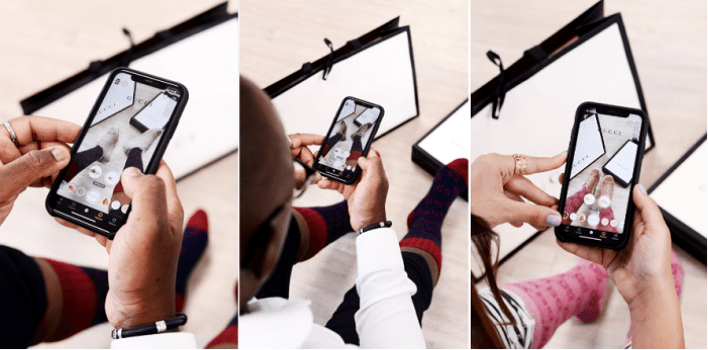
Just a few years ago, people needed specialized headsets to be able to experience AR. One of the first introductions of the technology on a large-scale platform was the use of branded social media filters. Filters on social media channels offer incredibly high engagement rates, as they’re housed on some of the most consistently used, high-touch platforms available. They also provide an undeniable “cool” factor that increases word-of-mouth referral and enhances brand awareness.

With Snapchat as the earliest adopter to offer filters to consumers, they’ve now become commonplace across channels.
In June 2020, Snapchat partnered with Gucci to launch a virtual-try-on filter. The feature let users virtually try on four different pairs of shoes while maintaining the environment around them.
Many brands are now offering branded filters, for everything from makeup products to gaming. Taco Bell released a record-breaking filter in 2020 which turned users into a taco, proving companies don’t have to take themselves too seriously on the road to innovation.
Preview Placement
Some industries feel the effects of product returns than others. While ecommerce overall carries a high likelihood of return, large products present an especially high cost. One of the verticals most affected is furniture. Because of the hefty price point and fulfillment cost associated with every order, retailers are eager to help customers get a clearer understanding of the product they’re buying, and how it will look in their space.
Using AR viewers, furniture retailers including Ikea, Burrow, Wayfair, and more have introduced product placement previews. Using this technology, you can place furniture items directly into the space you intend to place them. This gives customers an accurate look at how the pieces will look in their room of choice. Perhaps even more importantly, it can help highlight issues they might otherwise have overlooked.
Preview placements also encourage customers to view and try out many different options within their space. With different options available at a click, customers can see a variety of options they might not have otherwise considered, further increasing the likelihood of conversion.
Virtual Try-Ons
Ok, now we’ve covered big item returns. Now let’s see how AR can help reduce returns on small consumer goods as well. In recent years, many people were simply too reluctant to buy products they needed to try on via the internet. It makes sense – knowing how a product will look on you is a huge factor in the decision-making process. Retailers are busy innovating solutions to make at-home try-ons a possibility. Again, understanding how an item will look in the context of your life as a customer can help drive conversions and help reduce the number of returns.
More than 45% of online returns happen because of incorrect sizing, fit, or color. Of course, these are attributes that can be difficult to get a grasp on with simplified product pages. That’s where virtual try-ons come into play.

Warby Parker gained popularity for its Home Try-On program, which delivered five frame options to customers to try on, well, at home. Customers would take a style quiz, then choose from several recommended options. After five days, they’d send back the package and select the ones they liked best, then have a fresh pair sent out directly. While this model was hugely successful, it’s not especially sustainable, and it’s not the ticket for all customers. In lieu of the Home Try-on program, the brand introduced Virtual Try-on in its mobile app. The AR-powered uses infrared images to create a map of the customer’s face. Then, places each pair of virtual frames on them. With a recommendation tool that takes into account individuality, customers can complete an order in just a few clicks.
How Can Smaller Brands Leverage AR?
Sure, building a powerful branded app could be the ticket to offering AR experiences. With the right budget and resources, virtually any brand would do well to create immersive experiences. Unfortunately, this isn’t a realistic option for most companies. Instead, consider the tools you’ve already got at hand.
Some ecommerce platforms are placing more and more focus on immersive experiences, and are moving toward native offerings. Shopify boasts its own AR tool, making it possible for any Shopify merchant to create an AR experience without further integrations.
Retailers on other platforms have plenty of options, too. Apple’s ARKit lets retailers create iOS-compatible AR experiences without costly development initiatives. The tool’s Quick Look feature lets users view virtual 3D objects in Safari browsers, messages, mail accounts, and notes. It also allows retailers to embed Quick Look AR views into apps and websites in a real-world surrounding. Tools like these make AR accessible to retailers large and small, enabling them to offer cutting edge customer experiences.
While a virtual try-on feature might be a lofty goal for a burgeoning ecommerce merchant, other tools can offer similar experiences that make returns less likely, and customers more happy.
For example, specialty underwear retailer Tommy John offers a quiz to new customers so they can identify the styles and sizes right for them.
Once the system populates results, customers are led to a “Just for You” page. The page shows recommended products in styles and sizes that are sure to fit, thanks to the quiz data. Quiz questions about sizes, common issues with other underwear, and most important features. (Rejoice! Modern underwear can be feature-rich.) Extending the value of the feature, customers can refer back to the “Just for You” page for subsequent orders. Having made purchases before, customers understand the fit and sizing of the products they’re geetting. Meanwhile the system saves preferences for easy, reliable ordering.
Where to Start with Voice Commerce, AI, and AR
Now that you’ve had a healthy dose of inspiration, you might be feeling overwhelmed by all the possibilities. But let’s take it back a step. Remember that the objective of these technologies is to make buying from your store a better experience for your customers.
Ask yourself:
- What are the pain points in my customer journey?
- Where could I improve my browsing options?
- Which products would work well with these technologies?
- How can I gauge their success once applied?
Once you’ve nailed down the details, start exploring the solutions fit for your scenario. Not every brand needs virtual try-ons, and it’s safe to say, people aren’t likely to make high-dollar purchases using voice commands. Whatever direction you go, keep customers at the center of your efforts, and you’re sure to find success.
Look to partners and integrations for creative opportunities. SEO improvements and a focus on accurate product tagging can significantly improve your products’ position in visual and voice searches.
Chatbots, either through an integration or Google or Apple offering, are a great way to start improving customer engagement. A simple recommendation engine is also a valuable first step. They can be created using your ecommerce platform’s built-in AI, or an external plugin.
Finally, look to AR tools to deliver immersive experiences, but don’t feel like you need to dive straight in. Leveraging tools like Shopify’s native AR, or Apple’s ARKit can be a powerful solution right out of the box.
In the process of improving your store, you can’t afford to ignore your shipping experience. ShipperHQ is a comprehensive shipping rate management platform. It allows you to customize shipping methods and rules based on what you sell and how you run your business. Try it now for free to see how improving your shipping experience can improve your checkout.

